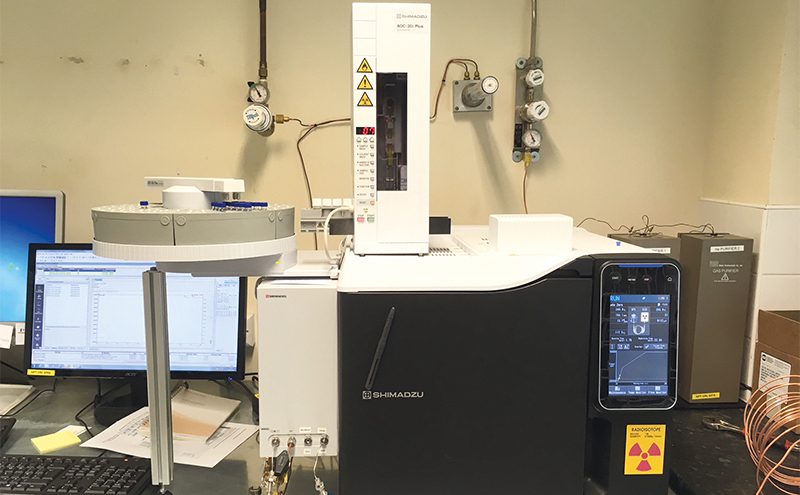Celtic Recycling is the only firm in the UK able to produce ‘good as new’ sulphur hexafluoride from discarded transformers, a service supported by the use of bespoke gas chromatography equipment, as this case study explains.
Celtic Recycling specializes in the recovery, management and recycling of redundant heavy electrical equipment, including the removal and dismantling of oil- and gas-filled transformers from National Grid sites across the UK. Both the oil and the gas can be recycled, after testing to ensure that the levels of any contaminants are within the specified limits. The company has long used gas chromatography (GC) to analyze polychlorinated biphenyls (PCBs) in insulating oils but lacked the capability to screen sulphur hexafluoride (SF6) from gas-filled equipment. With new legislation on the horizon that is set to make it more difficult to import virgin SF6, Celtic Recycling invested in a dual column Nexis GC-2030 to broaden its GC capabilities to include gas analysis.
Celtic Recycling is one of a small number of specialist contractors able to safely remove, dismantle and recycle end of life, high voltage electrical equipment. Its site in Newport, Gwent, is home to its laboratory responsible for the analysis of oil and gas from transformers for recycling, ensuring that levels of any contaminants fall below the specified threshold values. While the laboratory has been analyzing PCBs in insulating oils by GC for several years, SF6 analysis is a more recent challenge. Legislative changes are set to increase the demand for recycled SF6, and so the company upgraded to a customized Nexis GC-2030 to enable gas analysis and enhance PCB testing.
Why test for PCBs?
In the past, PCBs were used as dielectric insulating fluids in transformers and other high voltage electrical equipment. At the time they were thought of as the ‘wonder substance’ because they have superb insulating properties and don’t break down. Their use was banned in the 1980s after it became clear that they were hazardous to humans and the environment. However, insulating oil that contains PCBs is still occasionally found in older items of electrical equipment. While samples high in PCBs are very rare, trace-level contamination may still occur. Typically, this is attributed to PCBs being pumped out and replaced with an alternative oil to comply with legislation; any residual PCBs cause trace contamination of the fresh insulating oil. For this reason, all samples received by Celtic Recycling undergo quantitative GC analysis for PCBs over the range of 5 to 100 ppm. Samples below the legal limit of 50 ppm can be reused and recycled, while any oils containing PCBs above this level are treated as hazardous waste and destroyed.
The SF6 challenge
Changes to EU legislation since 2015 will make it increasingly difficult to produce or import new supplies of SF6, an inert gas with a global warming potential many thousands of times greater than CO2. SF6-filled equipment can be emptied and the gas recovered and stored, but great care must be taken in case arcing has occurred within the equipment, resulting in the formation of highly toxic contaminants. Portable analyzers give a broad indication of any contaminants that are present, such as hydrogen fluoride, sulphur dioxide and moisture, most of which can be removed using molecular sieves. One of the biggest contaminants is air, and Celtic Recycling has invested in an air-separation plant, enabling it to produce recycled SF6 of ‘good as new’ quality. Once the cleaned gas has been analyzed and its quality certified by quantitative GC analysis, it can be resold. Currently, no other company in the UK is able to offer this service.
A bespoke GC system
The firm wanted to increase capacity for PCB analysis and, at the same time, introduce GC screening of SF6, which could not be done using the laboratory’s existing instrument. While PCB testing can be performed using a standard GC set-up with an electron capture detector (ECD), SF6 requires a system tailored to gas analysis. This led the company to choose the GC-2030 from instrument manufacturer Shimadzu.
Shimadzu customized the system so that it samples SF6 directly from a gas cylinder, using a barrier discharge ionization detector (BID) to determine whether any contaminants were present. Shimadzu’s patented BID is a universal detector that can detect all organic compounds except He and Ne. It offers significantly enhanced sensitivity compared to thermal conductivity and flame ionization detectors – enabling the detection of all types of trace components at the 0.1 ppm level – and incorporates unique electrode-preserving plasma generation technology that ensures long-term stability. To avoid saturating the detector, the design incorporates a ‘dump valve’, allowing SF6 to be diverted once the substances of interest have eluted. PCB samples are introduced via a split/splitless injector, and analyzed using an ECD.
The Nexis GC-2030 was installed at the end of 2017. Not only has it extended the laboratory’s GC capabilities to include SF6 analysis, it also provides additional flexibility, as the SF6 and PCB set-ups are installed alongside each other in a single instrument. This avoids the need to switch out columns and change detectors, or to install two separate instruments, one for each type of analysis. The inclusion of a BID helps to futureproof the system, making it suitable for many other applications.
Previously, GC analysis was performed using nitrogen carrier gas, but the laboratory opted to use helium with the new set-up. This has reduced the PCB run time from 45 to 22 minutes, significantly improving turnaround times and allowing more samples to be run in the same time period as before. The system’s powerful LabSolutions software enhances integration, making it easier to detect small peaks and discern them from background noise, and resulting in increased PCB sensitivity compared to the laboratory’s older instrument.
To date, the implementation of the new GC assay has allowed Celtic Recycling to recover and certify over 3,000 kg of SF6 gas for sale and reuse in new equipment.







